2010 MERCEDES-BENZ GLK350 4MATIC dimensions
[x] Cancel search: dimensionsPage 9 of 344
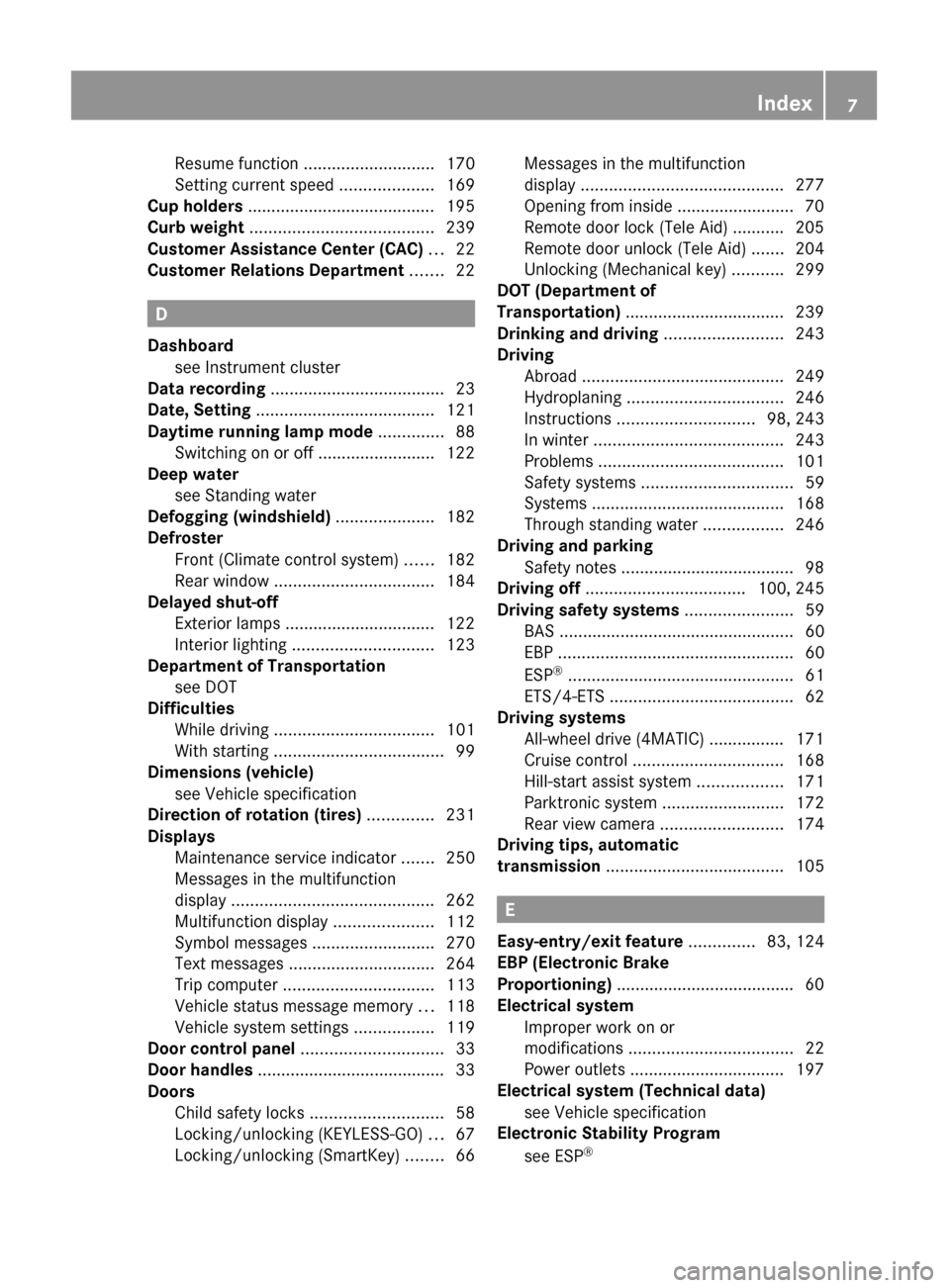
Resume function ............................ 170
Setting current speed ....................169
Cup holders ........................................ 195
Curb weight ....................................... 239
Customer Assistance Center (CAC) ... 22
Customer Relations Department ....... 22
D
Dashboard see Instrument cluster
Data recording ..................................... 23
Date, Setting ...................................... 121
Daytime running lamp mode .............. 88
Switching on or off ......................... 122
Deep water
see Standing water
Defogging (windshield) ..................... 182
Defroster
Front (Climate control system) ......182
Rear window .................................. 184
Delayed shut-off
Exterior lamps ................................ 122
Interior lighting .............................. 123
Department of Transportation
see DOT
Difficulties
While driving .................................. 101
With starting .................................... 99
Dimensions (vehicle)
see Vehicle specification
Direction of rotation (tires) .............. 231
Displays
Maintenance service indicator .......250
Messages in the multifunction
display ........................................... 262
Multifunction display .....................112
Symbol messages ..........................270
Text messages ............................... 264
Trip computer ................................ 113
Vehicle status message memory ...118
Vehicle system settings .................119
Door control panel .............................. 33
Door handles ........................................ 33
Doors
Child safety locks ............................ 58
Locking/unlocking (KEYLESS-GO) ...67
Locking/unlocking (SmartKey) ........66
Messages in the multifunction
display ........................................... 277
Opening from inside ......................... 70
Remote door lock (Tele Aid) ........... 205
Remote door unlock (Tele Aid) .......204
Unlocking (Mechanical key) ...........299
DOT (Department of
Transportation) .................................. 239
Drinking and driving ......................... 243
Driving
Abroad ........................................... 249
Hydroplaning ................................. 246
Instructions ............................. 98, 243
In winter ........................................ 243
Problems ....................................... 101
Safety systems ................................ 59
Systems ......................................... 168
Through standing water .................246
Driving and parking
Safety notes ..................................... 98
Driving off .................................. 100, 245
Driving safety systems ....................... 59
BAS .................................................. 60
EBP .................................................. 60
ESP ®
................................................ 61
ETS/4-ETS ....................................... 62
Driving systems
All-wheel drive (4MATIC) ................ 171
Cruise control ................................ 168
Hill-start assist system ..................171
Parktronic system ..........................172
Rear view camera .......................... 174
Driving tips, automatic
transmission ...................................... 105
E
Easy-entry/exit feature .............. 83, 124
EBP (Electronic Brake
Proportioning) ...................................... 60
Electrical system
Improper work on or
modifications ................................... 22
Power outlets ................................. 197
Electrical system (Technical data)
see Vehicle specification
Electronic Stability Program
see ESP ®
Index7X204_AKB; 3; 23, en-USd2ureepe,Version: 2.11.8.12009-07-16T19:16:58+02:00 - Seite 7
Page 18 of 344

Gasoline additives .......................... 337
Identification labels .......................328
Premium unleaded gasoline ...........336
Rims and tires ................................ 331
Spare wheel ................................... 333
Vehicle specification GLK 350 .......330
Vehicle specification
GLK 350 4MATIC ........................... 330
Washer and headlamp cleaning
system ................................... 335, 339
Technical data (dimensions)
see Vehicle specification
Technical data (electrical system)
see Vehicle specification
Technical data (engine)
see Vehicle specification
Technical data (weights)
see Vehicle specification
Tele Aid ............................................... 200
Emergency calls ............................. 201
Information button .........................203
Initiating an emergency call
manually ........................................ 202
Messages in the multifunction
display ........................................... 275
Remote door lock .......................... 205
Remote door unlock ......................204
Roadside Assistance button ..........203
Search & Send ............................... 204
SOS button .................................... 202
Stolen Vehicle Recovery Services ..205
System self-test ............................. 201
Telephone .................................... 29, 155
Answering/ending a call ................117
Call lists ......................................... 164
Emergency calls “911” ..................161
Hands-free microphone ...................32
Making calls ................................... 165
Menu ............................................. 117
Operation ....................................... 117
Phone book ........................... 117, 162
Redialing ........................................ 118
Temperature
Coolant .......................................... 109
Interior temperature ......................180
Outside .......................................... 110
Tether anchorage points
see Children in the vehicle Tie-down rings ................................... 188
Tightening torque
Wheels ........................................... 317
Time setting ....................................... 121
TIN (Tire Identification Number) ...... 241
Tire and Loading Information
placard ............................................... 227
Tire and loading terminology ........... 239
Tire Identification Number see TIN
Tire inflation pressure
Checking ........................................ 221
Important notes on ........................220
Label on the inside of fuel filler
flap ................................................ 220
Placard on driver’s door B-pillar .....227
Tire labeling ....................................... 235
Tire load rating .................................. 240
Tire ply composition and material
used .................................................... 241
Tire pressure loss warning system . 222
Tires ........................................... 218, 331
Advanced Tire Pressure
Monitoring System (Advanced
TPMS) ............................................ 224
Air pressure ................................... 219
Care and maintenance ...................232
Cleaning ......................................... 233
Direction of rotation, spinning .......231
Important notes on tire inflation
pressure ........................................ 220
Inflation pressure ........................... 221
Information placard .......................227
Inspection ...................................... 232
Labeling ......................................... 235
Load index ............................. 235, 240
Load rating .................................... 240
Messages in the multifunction
display ................................... 268, 288
Ply composition and material
used ............................................... 241
Problems under-/overinflation ......221
Retreads ........................................ 218
Rims and tires (technical data) ......331
Rotation ......................................... 234
Service life ..................................... 232
Sizes .............................................. 331
Snow chains .................................. 24216IndexX204_AKB; 3; 23, en-USd2ureepe,Version: 2.11.8.12009-07-16T19:16:58+02:00 - Seite 16
Page 19 of 344
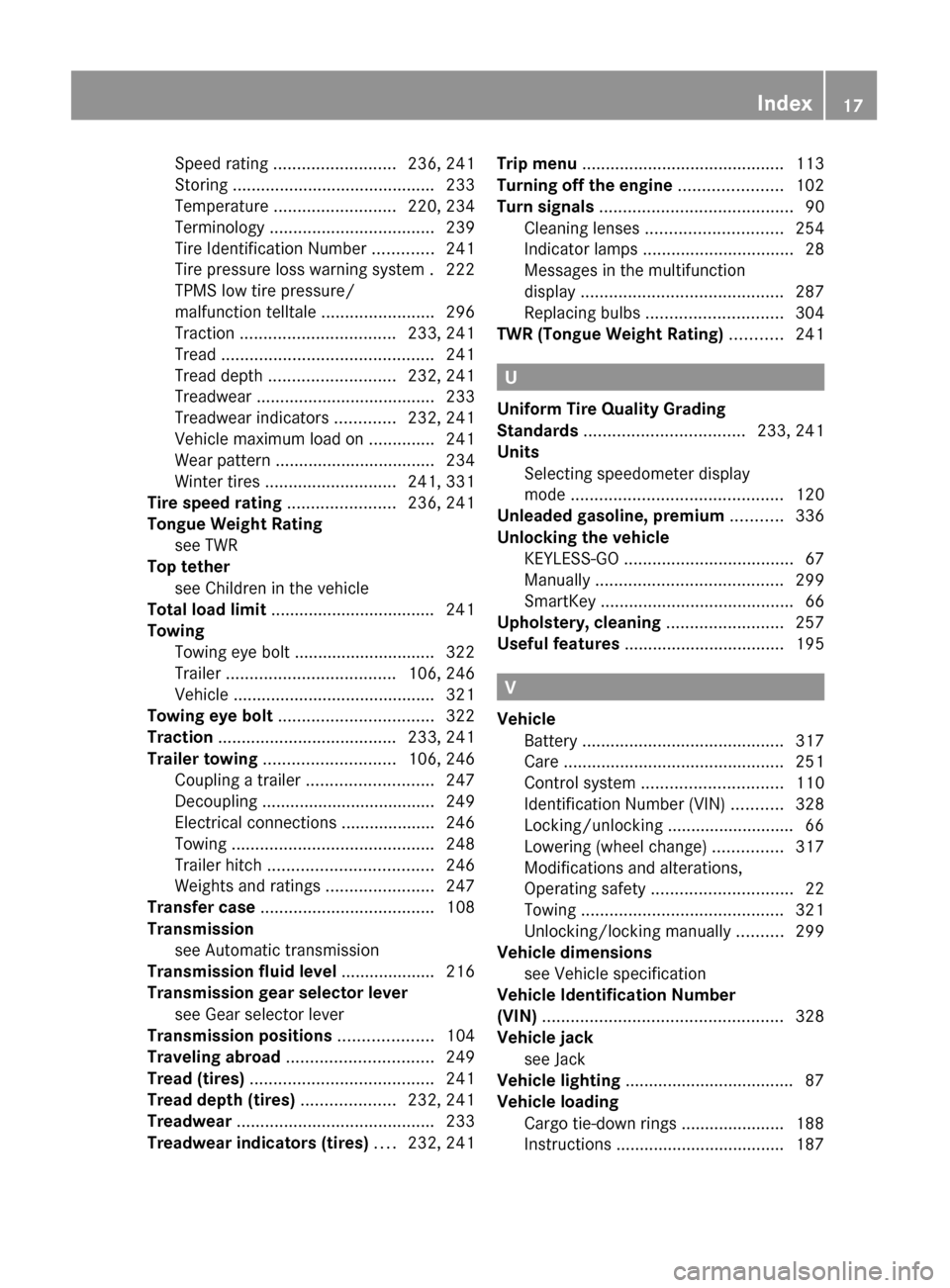
Speed rating .......................... 236, 241
Storing ........................................... 233
Temperature .......................... 220, 234
Terminology ................................... 239
Tire Identification Number .............241
Tire pressure loss warning system . 222
TPMS low tire pressure/
malfunction telltale ........................296
Traction ................................. 233, 241
Tread ............................................. 241
Tread depth ........................... 232, 241
Treadwear ...................................... 233
Treadwear indicators .............232, 241
Vehicle maximum load on ..............241
Wear pattern .................................. 234
Winter tires ............................ 241, 331
Tire speed rating ....................... 236, 241
Tongue Weight Rating see TWR
Top tether
see Children in the vehicle
Total load limit ................................... 241
Towing
Towing eye bolt .............................. 322
Trailer .................................... 106, 246
Vehicle ........................................... 321
Towing eye bolt ................................. 322
Traction ...................................... 233, 241
Trailer towing ............................ 106, 246
Coupling a trailer ........................... 247
Decoupling ..................................... 249
Electrical connections .................... 246
Towing ........................................... 248
Trailer hitch ................................... 246
Weights and ratings .......................247
Transfer case ..................................... 108
Transmission see Automatic transmission
Transmission fluid level .................... 216
Transmission gear selector lever see Gear selector lever
Transmission positions .................... 104
Traveling abroad ............................... 249
Tread (tires) ....................................... 241
Tread depth (tires) .................... 232, 241
Treadwear .......................................... 233
Treadwear indicators (tires) .... 232, 241Trip menu ........................................... 113
Turning off the engine ...................... 102
Turn signals ......................................... 90
Cleaning lenses ............................. 254
Indicator lamps ................................ 28
Messages in the multifunction
display ........................................... 287
Replacing bulbs ............................. 304
TWR (Tongue Weight Rating) ........... 241
U
Uniform Tire Quality Grading
Standards .................................. 233, 241
Units
Selecting speedometer display
mode ............................................. 120
Unleaded gasoline, premium ........... 336
Unlocking the vehicle
KEYLESS-GO .................................... 67
Manually ........................................ 299
SmartKey ......................................... 66
Upholstery, cleaning ......................... 257
Useful features .................................. 195
V
Vehicle
Battery ........................................... 317
Care ............................................... 251
Control system .............................. 110
Identification Number (VIN) ...........328
Locking/unlocking ........................... 66
Lowering (wheel change) ...............317
Modifications and alterations,
Operating safety .............................. 22
Towing ........................................... 321
Unlocking/locking manually ..........299
Vehicle dimensions
see Vehicle specification
Vehicle Identification Number
(VIN) ................................................... 328
Vehicle jack see Jack
Vehicle lighting .................................... 87
Vehicle loading
Cargo tie-down rings ...................... 188
Instructions .................................... 187
Index17X204_AKB; 3; 23, en-USd2ureepe,Version: 2.11.8.12009-07-16T19:16:58+02:00 - Seite 17
Page 236 of 344
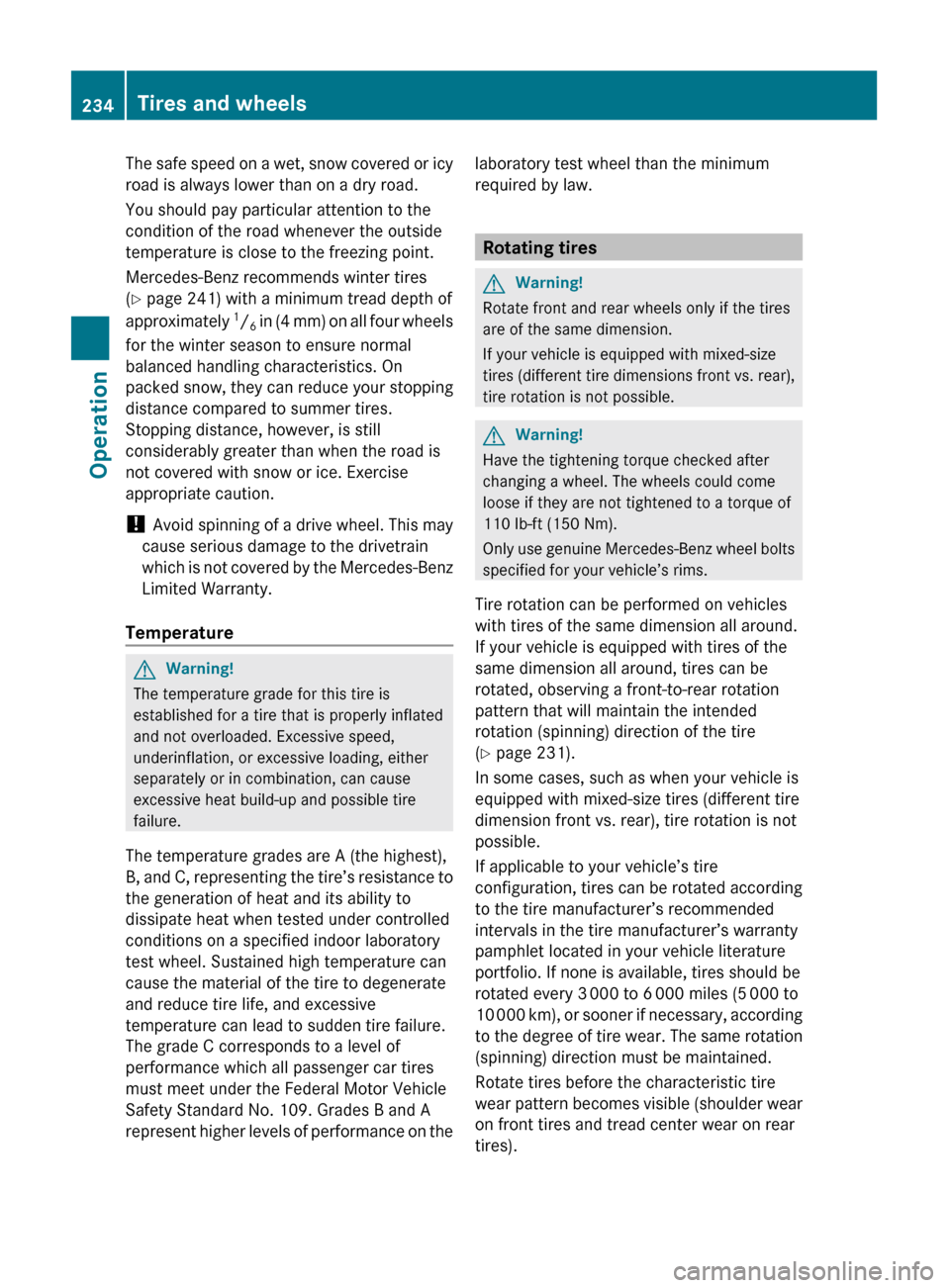
The safe speed on a wet, snow covered or icy
road is always lower than on a dry road.
You should pay particular attention to the
condition of the road whenever the outside
temperature is close to the freezing point.
Mercedes-Benz recommends winter tires
( Y page 241) with a minimum tread depth of
approximately 1
/ 6 in (4 mm) on all four wheels
for the winter season to ensure normal
balanced handling characteristics. On
packed snow, they can reduce your stopping
distance compared to summer tires.
Stopping distance, however, is still
considerably greater than when the road is
not covered with snow or ice. Exercise
appropriate caution.
! Avoid spinning of a drive wheel. This may
cause serious damage to the drivetrain
which is not covered by the Mercedes-Benz
Limited Warranty.
Temperature GWarning!
The temperature grade for this tire is
established for a tire that is properly inflated
and not overloaded. Excessive speed,
underinflation, or excessive loading, either
separately or in combination, can cause
excessive heat build-up and possible tire
failure.
The temperature grades are A (the highest),
B, and C, representing the tire’s resistance to
the generation of heat and its ability to
dissipate heat when tested under controlled
conditions on a specified indoor laboratory
test wheel. Sustained high temperature can
cause the material of the tire to degenerate
and reduce tire life, and excessive
temperature can lead to sudden tire failure.
The grade C corresponds to a level of
performance which all passenger car tires
must meet under the Federal Motor Vehicle
Safety Standard No. 109. Grades B and A
represent higher levels of performance on the
laboratory test wheel than the minimum
required by law.
Rotating tires
GWarning!
Rotate front and rear wheels only if the tires
are of the same dimension.
If your vehicle is equipped with mixed-size
tires (different tire dimensions front vs. rear),
tire rotation is not possible.
GWarning!
Have the tightening torque checked after
changing a wheel. The wheels could come
loose if they are not tightened to a torque of
110 lb-ft (150 Nm).
Only use genuine Mercedes-Benz wheel bolts
specified for your vehicle’s rims.
Tire rotation can be performed on vehicles
with tires of the same dimension all around.
If your vehicle is equipped with tires of the
same dimension all around, tires can be
rotated, observing a front-to-rear rotation
pattern that will maintain the intended
rotation (spinning) direction of the tire
( Y page 231).
In some cases, such as when your vehicle is
equipped with mixed-size tires (different tire
dimension front vs. rear), tire rotation is not
possible.
If applicable to your vehicle’s tire
configuration, tires can be rotated according
to the tire manufacturer’s recommended
intervals in the tire manufacturer’s warranty
pamphlet located in your vehicle literature
portfolio. If none is available, tires should be
rotated every 3 000 to 6 000 miles (5 000 to
10 000 km), or sooner if necessary, according
to the degree of tire wear. The same rotation
(spinning) direction must be maintained.
Rotate tires before the characteristic tire
wear pattern becomes visible (shoulder wear
on front tires and tread center wear on rear
tires).
234Tires and wheelsOperation
X204_AKB; 3; 23, en-USd2ureepe,Version: 2.11.8.12009-07-16T19:16:58+02:00 - Seite 234
Page 249 of 344

Vehicle and trailer weights and ratings
The Gross Trailer Weight (GTW) is the weight
of the trailer plus the weight of all cargo,
equipment, luggage, etc. loaded on the
trailer. The maximum permissible GTW to be
towed: 3 500 lb (1 588 kg).
Trailer Tongue Weight Rating (TWR) is the
maximum permissible weight on the trailer
tongue: 280 lb (127 kg) limit for Mercedes-
Benz approved hitch receiver.
Loading a trailer
R When loading a trailer, you should observe
that neither the permissible GTW, nor the
Gross Vehicle Weight Rating (GVWR) are
exceeded. The GVWR is indicated on the
certification label located on the driver’s
door B-pillar ( Y page 227).
Maximum permissible values are listed on
the safety compliance certification labels
for the vehicle and for the trailer to be
towed.
The lowest value listed must be selected
when determining how the vehicle and
trailer are loaded.
R The tongue weight at the hitch ball must be
added to the rear axle weight to prevent
exceeding the rear Gross Axle Weight
Rating (GAWR). The GAWR is indicated on
the certification label located on the
driver’s door B-pillar ( Y page 227).
i Mercedes-Benz recommends loading the
trailer in such a manner that it has a tongue
weight between 8 % and 10 % of the GTW.
i The weight of other accessories,
passengers and cargo will reduce the
maximum trailer weight and tongue weight
your vehicle can tow.
Checking weights of vehicle and trailer
R To assure that the towing vehicle and trailer
are in compliance with the maximum
permissible weight limits, have the loaded
rig (towing vehicle including driver,
passengers and cargo, trailer fully loaded)
weighed on a commercial scale.
R Check the vehicle’s front and rear gross
axle weight, the Gross Trailer Weight (GTW)
and tongue weight.
The values as measured must not exceed
the weight limits listed under “Vehicle and
trailer weights and ratings” ( Y page 247).
Coupling a trailer
Observe maximum permitted trailer
dimensions (width and length).
Most states and all Canadian provinces
require
R safety chains between the towing vehicle
and the trailer
The chains should be criss-crossed under
the trailer tongue. They must be attached
to the hitch receiver, and not to the
vehicle’s bumper or axle.
Make sure to leave enough slack in the
chains to permit turning corners.
R a separate brake system at various trailer
weights
R a break-away switch on trailers with a
separate brake system.
Check with your local state laws for specific
requirements.
The switch activates the trailer brakes in
the possible event that the trailer might
separate from the tow vehicle.
! Do not connect a trailer brake system (if
trailer is so equipped) directly to the
vehicle’s hydraulic brake system, as your
vehicle is equipped with antilock brakes. If
you do, neither the vehicle’s brakes nor the
trailer’s brakes will function properly.
i The provided vehicle electrical wiring
harness for trailer towing has a brake signal
wire for hook-up to a brake controller.
Driving instructions247OperationX204_AKB; 3; 23, en-USd2ureepe,Version: 2.11.8.12009-07-16T19:16:58+02:00 - Seite 247Z
Page 314 of 344
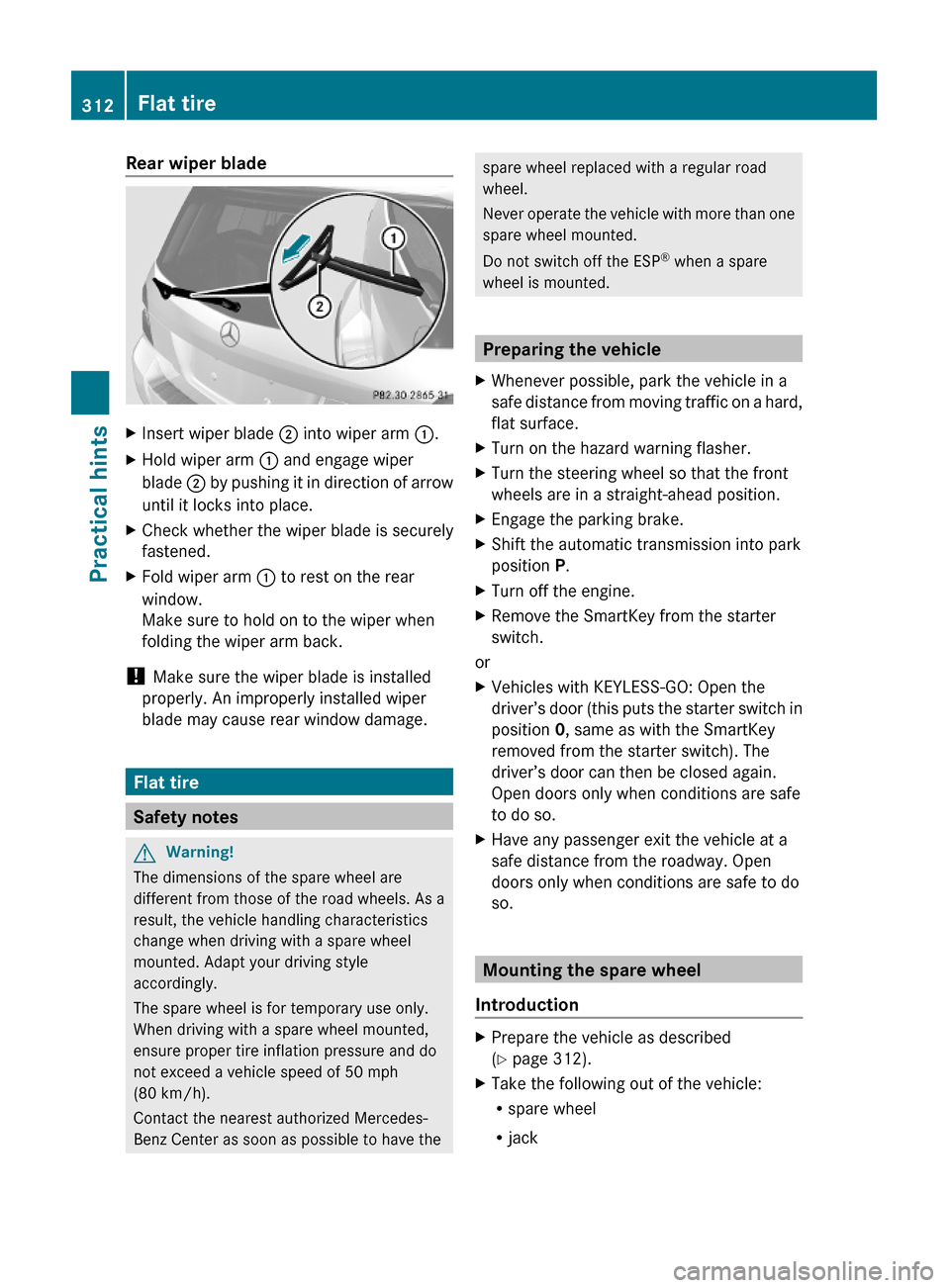
Rear wiper bladeXInsert wiper blade ; into wiper arm :.XHold wiper arm : and engage wiper
blade ; by pushing it in direction of arrow
until it locks into place.
XCheck whether the wiper blade is securely
fastened.
XFold wiper arm : to rest on the rear
window.
Make sure to hold on to the wiper when
folding the wiper arm back.
! Make sure the wiper blade is installed
properly. An improperly installed wiper
blade may cause rear window damage.
Flat tire
Safety notes
GWarning!
The dimensions of the spare wheel are
different from those of the road wheels. As a
result, the vehicle handling characteristics
change when driving with a spare wheel
mounted. Adapt your driving style
accordingly.
The spare wheel is for temporary use only.
When driving with a spare wheel mounted,
ensure proper tire inflation pressure and do
not exceed a vehicle speed of 50 mph
(80 km/h).
Contact the nearest authorized Mercedes-
Benz Center as soon as possible to have the
spare wheel replaced with a regular road
wheel.
Never operate the vehicle with more than one
spare wheel mounted.
Do not switch off the ESP® when a spare
wheel is mounted.
Preparing the vehicle
XWhenever possible, park the vehicle in a
safe distance from moving traffic on a hard,
flat surface.
XTurn on the hazard warning flasher.XTurn the steering wheel so that the front
wheels are in a straight-ahead position.
XEngage the parking brake.XShift the automatic transmission into park
position P.
XTurn off the engine.XRemove the SmartKey from the starter
switch.
or
XVehicles with KEYLESS-GO: Open the
driver’s door (this puts the starter switch in
position 0, same as with the SmartKey
removed from the starter switch). The
driver’s door can then be closed again.
Open doors only when conditions are safe
to do so.
XHave any passenger exit the vehicle at a
safe distance from the roadway. Open
doors only when conditions are safe to do
so.
Mounting the spare wheel
Introduction
XPrepare the vehicle as described
(Y page 312).
XTake the following out of the vehicle:
Rspare wheel
Rjack
312Flat tirePractical hints
X204_AKB; 3; 23, en-USd2ureepe,Version: 2.11.8.12009-07-16T19:16:58+02:00 - Seite 312
Page 332 of 344
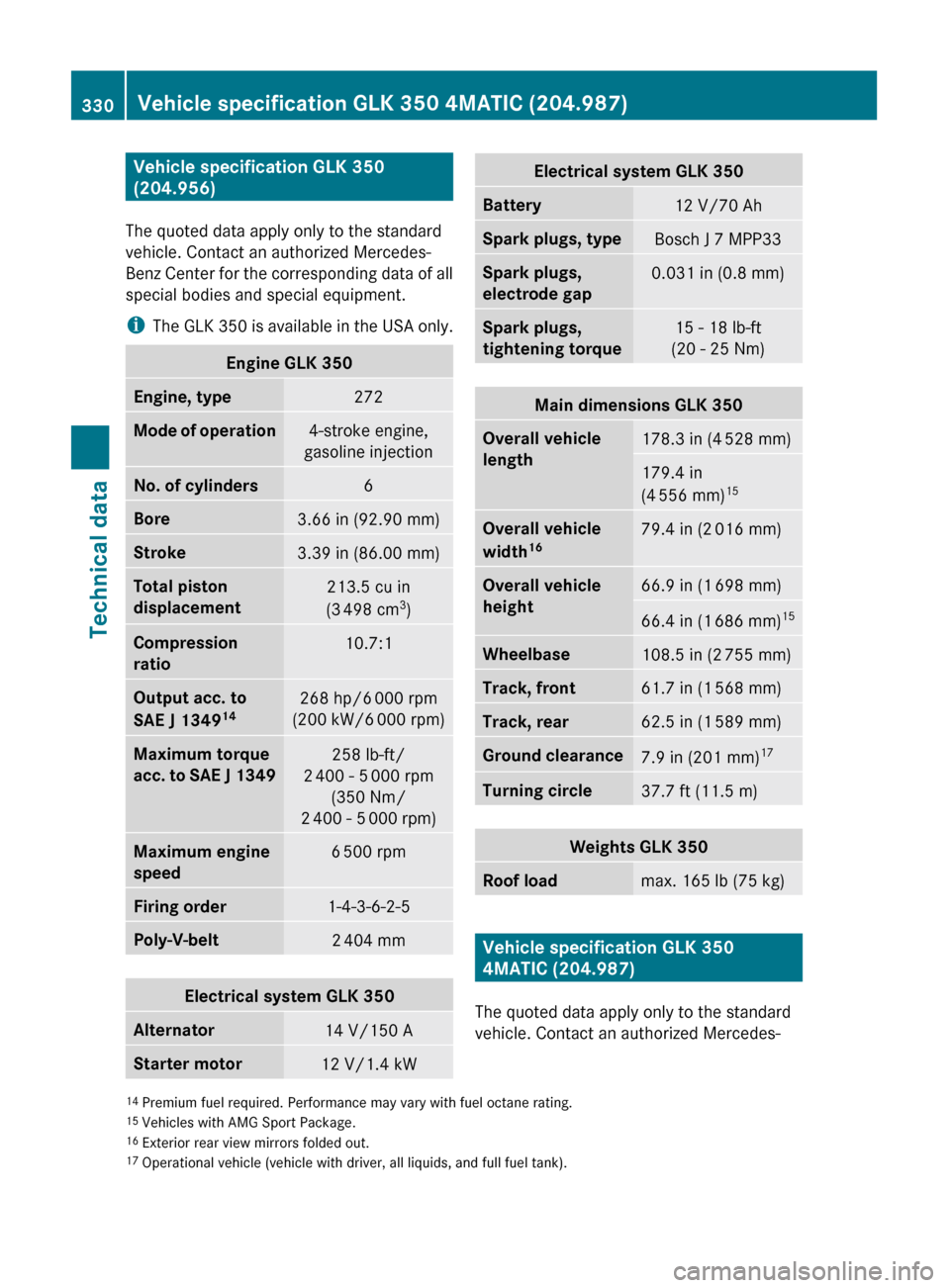
Vehicle specification GLK 350
(204.956)
The quoted data apply only to the standard
vehicle. Contact an authorized Mercedes-
Benz Center for the corresponding data of all
special bodies and special equipment.
i The GLK 350 is available in the USA only.Engine GLK 350Engine, type272Mode of operation4-stroke engine,
gasoline injectionNo. of cylinders6Bore3.66 in (92.90 mm)Stroke3.39 in (86.00 mm)Total piston
displacement213.5 cu in
(3 498 cm 3
)Compression
ratio10.7:1Output acc. to
SAE J 1349 14268 hp/6
000 rpm
(200 kW/6 000 rpm)Maximum torque
acc. to SAE J 1349258 lb-ft/
2 400 - 5 000 rpm
(350 Nm/
2 400 - 5 000 rpm)Maximum engine
speed6 500 rpmFiring order1-4-3-6-2-5Poly-V-belt2 404 mmElectrical system GLK 350Alternator14 V/150 AStarter motor12 V/1.4 kWElectrical system GLK 350Battery12 V/70 AhSpark plugs, typeBosch J 7 MPP33Spark plugs,
electrode gap0.031 in (0.8 mm)Spark plugs,
tightening torque15 - 18 lb-ft
(20 - 25 Nm)Main dimensions GLK 350Overall vehicle
length178.3 in (4 528 mm)179.4 in
(4 556 mm) 15Overall vehicle
width 1679.4 in (2
016 mm)Overall vehicle
height66.9 in (1 698 mm)66.4 in (1 686 mm) 15Wheelbase108.5 in (2
755 mm)Track, front61.7 in (1 568 mm)Track, rear62.5 in (1 589 mm)Ground clearance7.9 in (201 mm) 17Turning circle37.7 ft (11.5 m)Weights GLK 350Roof loadmax. 165 lb (75 kg)
Vehicle specification GLK 350
4MATIC (204.987)
The quoted data apply only to the standard
vehicle. Contact an authorized Mercedes-
14 Premium fuel required. Performance may vary with fuel octane rating.
15 Vehicles with AMG Sport Package.
16 Exterior rear view mirrors folded out.
17 Operational vehicle (vehicle with driver, all liquids, and full fuel tank).330Vehicle specification GLK 350 4MATIC (204.987)Technical data
X204_AKB; 3; 23, en-USd2ureepe,Version: 2.11.8.12009-07-16T19:16:58+02:00 - Seite 330
Page 333 of 344
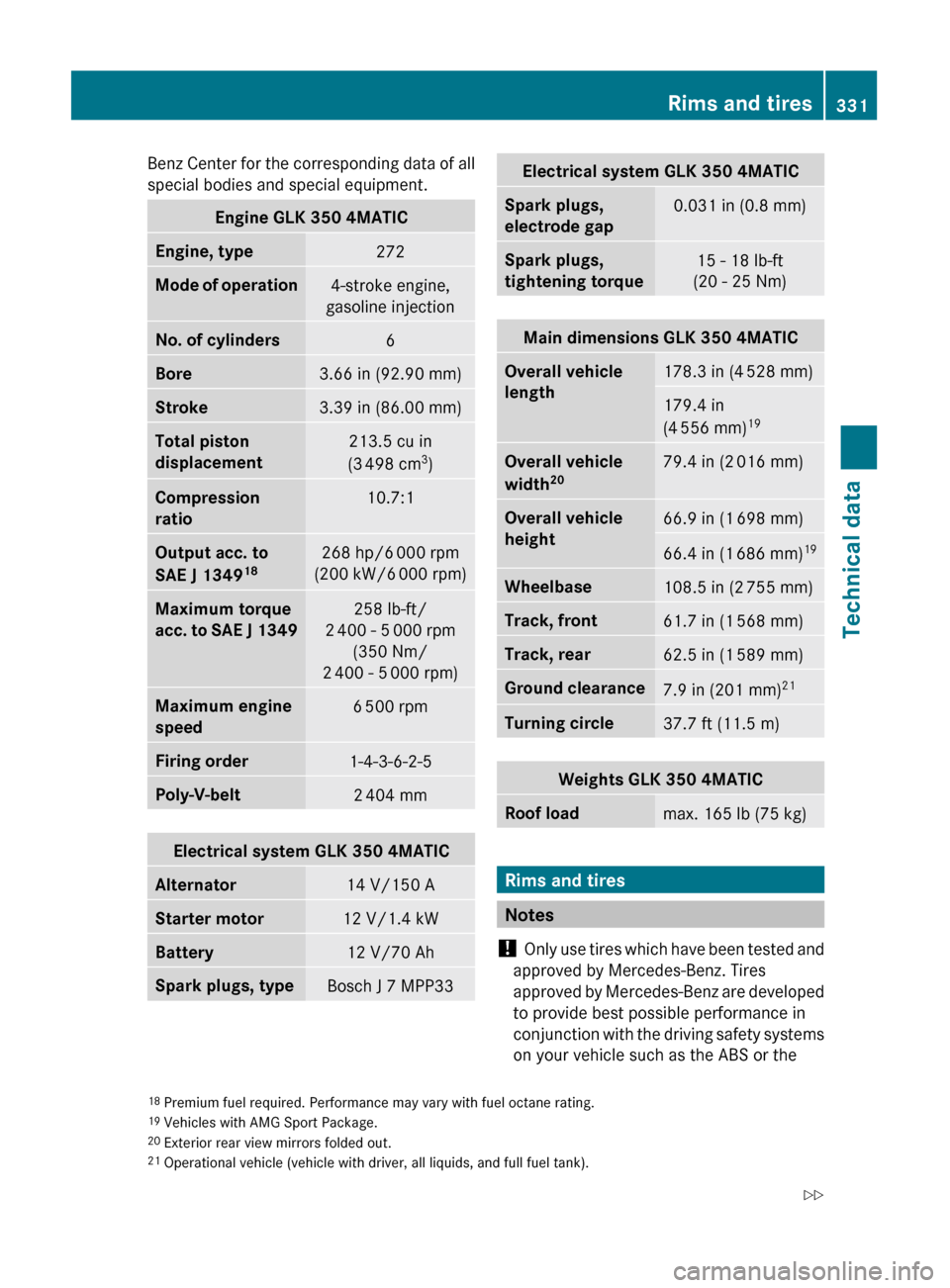
Benz Center for the corresponding data of all
special bodies and special equipment.Engine GLK 350 4MATICEngine, type272Mode of operation4-stroke engine,
gasoline injectionNo. of cylinders6Bore3.66 in (92.90 mm)Stroke3.39 in (86.00 mm)Total piston
displacement213.5 cu in
(3 498 cm 3
)Compression
ratio10.7:1Output acc. to
SAE J 1349 18268 hp/6
000 rpm
(200 kW/6 000 rpm)Maximum torque
acc. to SAE J 1349258 lb-ft/
2 400 - 5 000 rpm
(350 Nm/
2 400 - 5 000 rpm)Maximum engine
speed6 500 rpmFiring order1-4-3-6-2-5Poly-V-belt2 404 mmElectrical system GLK 350 4MATICAlternator14 V/150 AStarter motor12 V/1.4 kWBattery12 V/70 AhSpark plugs, typeBosch J 7 MPP33Electrical system GLK 350 4MATICSpark plugs,
electrode gap0.031 in (0.8 mm)Spark plugs,
tightening torque15 - 18 lb-ft
(20 - 25 Nm)Main dimensions GLK 350 4MATICOverall vehicle
length178.3 in (4 528 mm)179.4 in
(4 556 mm) 19Overall vehicle
width 2079.4 in (2
016 mm)Overall vehicle
height66.9 in (1 698 mm)66.4 in (1 686 mm) 19Wheelbase108.5 in (2
755 mm)Track, front61.7 in (1 568 mm)Track, rear62.5 in (1 589 mm)Ground clearance7.9 in (201 mm) 21Turning circle37.7 ft (11.5 m)Weights GLK 350 4MATICRoof loadmax. 165 lb (75 kg)
Rims and tires
Notes
! Only use tires which have been tested and
approved by Mercedes-Benz. Tires
approved by Mercedes-Benz are developed
to provide best possible performance in
conjunction with the driving safety systems
on your vehicle such as the ABS or the
18 Premium fuel required. Performance may vary with fuel octane rating.
19 Vehicles with AMG Sport Package.
20 Exterior rear view mirrors folded out.
21 Operational vehicle (vehicle with driver, all liquids, and full fuel tank).Rims and tires331Technical dataX204_AKB; 3; 23, en-USd2ureepe,Version: 2.11.8.12009-07-16T19:16:58+02:00 - Seite 331Z